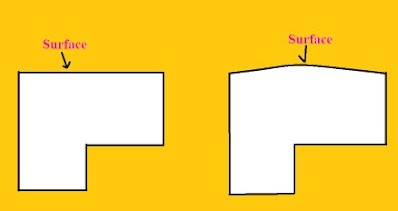In this article we will see new topic Flatness Testing - Mechanical engineering so this is important topic in Metrology and quality control,
Flatness Testing - Mechanical engineering
Flatness
Flatness is defined as departure to the surface from ideal flat surface. Autocollimator or spirit level is moved along three directions. CA, BC, and AB shown in fig. The movements have three different points A, B, and C for Identity. Through the points a plane can defined. Now autocollimator move in practically in all directions. Surface characteristics is noted down.
The deviation of surface from the surface to the reference plane is called flatness.
 |
| Movement of autocollimeter above surface |
Flatness Testing
Flat testing is possible by the comparing to the surface with accurate surface
Flatness inaccuracy of the surface states that departure against flatness is minimum separation of pair a parallel planes will be just contact all points on the surface.
 |
| Flatness |
Flatness variation (errors) are specify as follows,
a) mm per metre when convexities are allowed.
b) Concave to.... or mm, when in the ends, only allowing concave surface.
c) Convex to.... or mm, when in the ends, only allowing convex surface.
Flatness testing of surface can be tested by
1) Surface plate 2) Beam comparator 3) Autocollimator 4) Interferometers
5) Precision level 6) Optical flats
In mechanical industries to check the flatness filler gauges are used. In filler gauges are various sizes are available0.03 to 0.63 mm. Variation of large surface similarly surface table from true plane may be determined by use of autocollimeter or spirit level.
What is the purpose of flatness?
Precision and Accuracy
Machining and Assembly:
Component Fit: Ensuring flatness in machined parts is crucial for proper assembly and fit. Components that fit together accurately help maintain the structural integrity and functionality of mechanical systems.
Sealing Surfaces: Flat surfaces are essential for creating effective seals between components, such as in gaskets and flanges, to prevent leaks of fluids or gases.
Measurement and Calibration:
Surface Plates: Flat surfaces, such as those on surface plates, are used as reference standards in measurement and calibration processes. This ensures that tools and components are produced within specified tolerances.
Reduction of Wear and Tear
Load Distribution:
Bearing Surfaces: Flatness in bearing surfaces helps distribute loads evenly, reducing localized stress and wear. This prolongs the life of the bearings and other components.
Friction Reduction: Flat mating surfaces minimize friction between moving parts, reducing wear and improving the efficiency and longevity of the machinery.
Structural Integrity
Alignment and Stability:
Machine Beds and Foundations: Flatness in machine beds and foundations ensures proper alignment and stability of machinery. This is essential for maintaining the accuracy of machining operations and preventing vibrations that can affect performance.
Structural Components: Flat surfaces in structural components, such as beams and plates, ensure that loads are evenly distributed, which is critical for the safety and durability of structures.
Thermal and Dynamic Performance
Thermal Expansion:
Controlled Expansion: Flat surfaces can help manage thermal expansion and contraction in mechanical systems. This is particularly important in applications where temperature changes are frequent, as uneven surfaces can lead to misalignment or mechanical failure.
Heat Transfer: In heat exchangers and similar applications, flat surfaces can enhance the efficiency of heat transfer.
Surface Finish and Quality Control
Inspection and Verification:
Quality Assurance: Flatness is a key parameter checked during quality control inspections to ensure that manufactured parts meet design specifications and functional requirements.
Surface Finish: A flat surface often correlates with a high-quality surface finish, which is important for aesthetic and functional purposes in many mechanical components.
Functionality and Performance
Operational Efficiency:
Component Interaction: Flat surfaces ensure smooth interaction between components, which is crucial for the overall efficiency and performance of mechanical systems.
Precision Motion: In applications involving precision motion, such as in linear guides and slides, flatness is essential to ensure accurate and smooth movement.
In summary, flatness in mechanical engineering is crucial for ensuring precision, reducing wear and tear, maintaining structural integrity, enhancing thermal and dynamic performance, ensuring quality control, and improving overall functionality and performance of mechanical systems.
What is the unit of flatness?
Flatness is measured in units of length, typically micrometers (µm), millimeters (mm), or inches (in). It quantifies the deviation of a surface from being perfectly flat.
Flatness is crucial in precision engineering, manufacturing, and quality control to ensure proper fitting, function, and performance of mechanical components.
Common tools for measuring flatness include straightedges with feeler gauges, dial indicators, optical flats, coordinate measuring machines (CMMs), and laser scanners.
In this article we discussed topic Flatness Testing - Mechanical engineering hope you understand well. Thanks for reading it.
If you have any query comments below.


.jpg)



